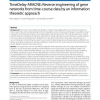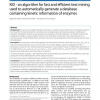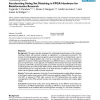1411 search results - page 276 / 283 » Discriminative Random Fields |
BMCBI
2010
13 years 7 months ago
2010
Background: One of main aims of Molecular Biology is the gain of knowledge about how molecular components interact each other and to understand gene function regulations. Using mi...
BMCBI
2010
13 years 7 months ago
2010
Background: The amount of available biological information is rapidly increasing and the focus of biological research has moved from single components to networks and even larger ...
BMCBI
2008
13 years 7 months ago
2008
Background: Cellular metabolism is one of the most investigated system of biological interactions. While the topological nature of individual reactions and pathways in the network...
BMCBI
2008
13 years 7 months ago
2008
Background: This paper describes techniques for accelerating the performance of the string set matching problem with particular emphasis on applications in computational proteomic...
BMCBI
2007
13 years 7 months ago
2007
Background: Relating features of protein sequences to structural hinges is important for identifying domain boundaries, understanding structure-function relationships, and designi...




